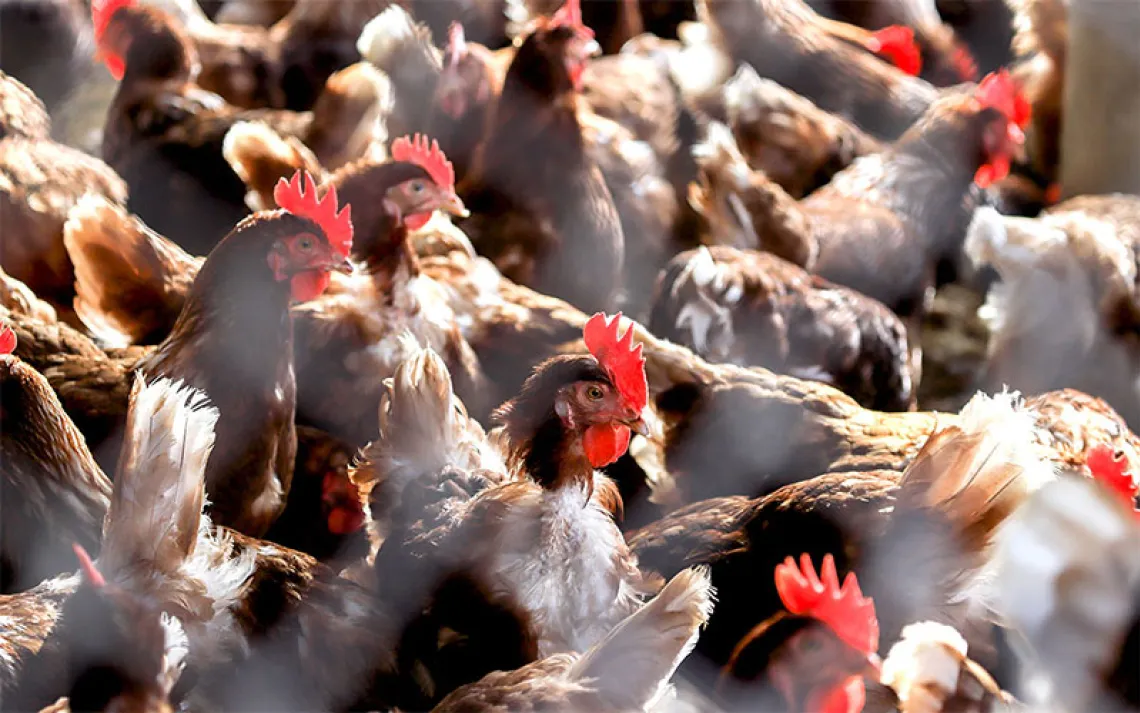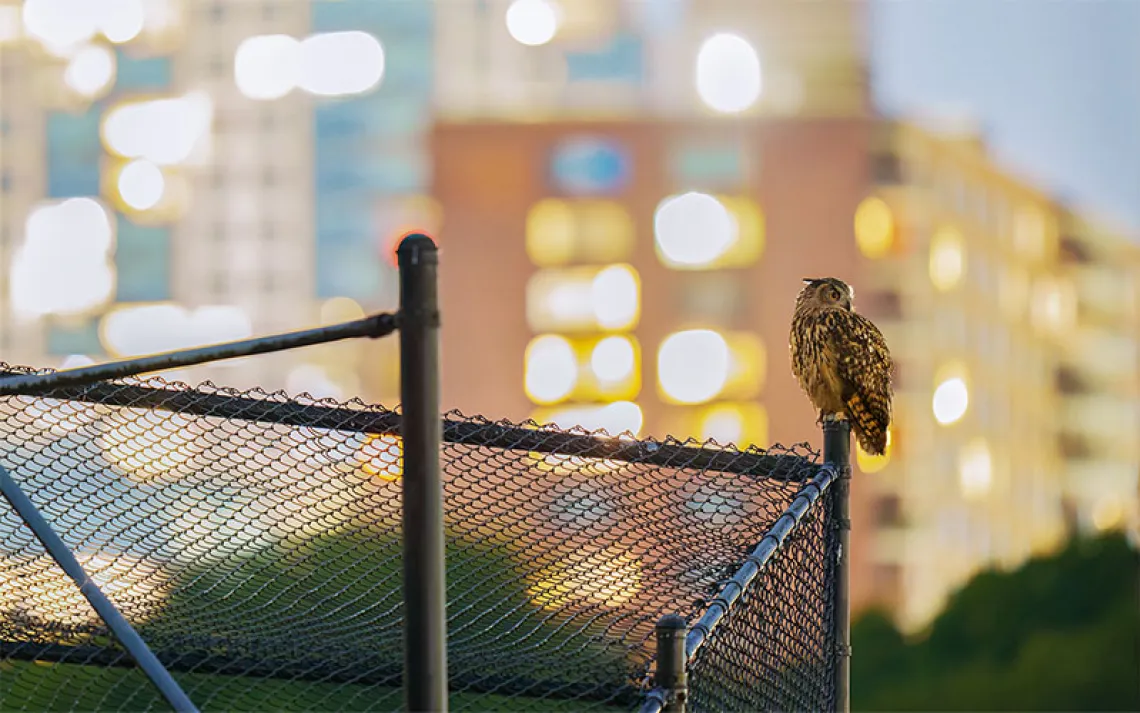With Some Help, an Endangered Plover Survives Against the Odds
High waters and the pandemic threaten piping plovers nesting on the Great Lakes

Joe | Photo by Alice Van Zoeren
As former vice president Joe Biden battled this summer to win the presidency, a Great Lakes piping plover named after the candidate was beginning a different sort of battle. The chick’s mother had abandoned him on June 2, when he was still inside his egg at Sleeping Bear Dunes National Lakeshore in northern Michigan. “Joe’s” egg was rescued by humans just before record-high lake levels, as well as a vicious storm, threatened to wash it away. Other piping plover nests weren’t so lucky. At least 13 nests were washed away—a record for the endangered species.
“They have hard times in a normal year,’’ says Vince Cavalieri, a National Park Service wildlife biologist. Before coming to NPS, Cavalieri oversaw the piping plover recovery program for the US Fish and Wildlife Service, and he has plenty of stories about how difficult it has been to preserve the species, like the time he ran down the Lake Michigan shoreline yelling at an ATV driver who was coming within a few feet of a nest. It used to be that Cavalieri had plenty of partners to help with his work, but the pandemic left him short-staffed and made it more difficult to safeguard the plovers.
The pandemic and record-high waters on Lake Michigan this year threatened to undo decades of painstaking progress for a species iconic to the Great Lakes and the region’s dunes.
The Great Lakes piping plover has been classified as endangered since the 1980s, when its numbers reached alarmingly low levels. There are three populations of piping plovers in the United States and Canada: the Atlantic, the Northern Great Plains, and the Great Lakes. While all three populations are threatened, the Great Lakes piping plovers are especially at risk. Each year, they migrate from as far south as the Bahamas northward to the Great Lakes and Canada to breed, showing more fidelity to one breeding ground year after year than any particular mate. The piping plover lays its eggs on open, pebbly beaches, making them vulnerable to predators and the loss of their habitat. Over the years, encroaching human development has reduced the number of nesting sites and contributed to the species’ decline. “What we’re most concerned about is losing habitat due to high water and increased frequency and severity of storms,” says University of Minnesota Professor Francie Cuthbert, who has been trying to increase the number of nesting pairs since the mid-1980s.
Beach development and recreation after World War II slowly diminished the piping plover population; by 1990, they had dwindled to just 12 breeding pairs. In the years since, multiple federal and state agencies, including the National Park Service, US Fish & Wildlife Service, Native American nations, universities, zoos, and nonprofit groups, have worked together to bring the population back to about 64 breeding pairs in the Great Lakes. They’ve done that through habitat restoration, nest monitoring, and caging nests to keep out predators as well as rescuing abandoned eggs like that of chick Joe Biden.
It hasn’t been easy. A few years ago, for example, biologists tried to capture a plucky plover named Violet after she got a piece of fiber wrapped around her toes, but they couldn’t catch her, and she lost the foot. Once, a bird named Rocky accidentally spent a season incubating rocks. (To find out more about the mating habits of plovers, see this.) “It’s all pretty tenuous,’’ said Alice Van Zoeren, observation coordinator for the Great Lakes Piping Plover conservation team. “I wouldn’t say it’s an unmitigated success.”
The birds still have a long way to go to recovery, Cavalieri said. The goal is 150 breeding pairs, including 50 pairs outside Michigan in their historic breeding grounds in Wisconsin, Illinois, and Ontario.
While even a normal year poses many challenges for the recovery effort, the birds and their advocates have faced their biggest test in 2020. This spring, with record-high lake levels, “we knew there was going to be trouble,’’ says Cuthbert. The pandemic meant that she and the team had fewer staff members and volunteers to provide care for abandoned eggs after a record-high number of nest washouts.

Craig Campeau and Vince Cavalieri release chicks at Sleeping Bear Dune. | Photo by Naomi Snyder

Vince Cavalieri | Photo by Naomi Snyder
Normally, zookeepers from all over the country travel to the University of Michigan Biological Station near the northern tip of Lower Michigan to incubate and rear abandoned eggs and chicks. It’s an intensive process that involves keeping the eggs at a constant 99° F. But this year, zoos didn’t send zookeepers to northern Michigan. There were travel bans, and the biological station was temporarily closed to researchers, Cuthbert said.
In the midst of the COVID-19 restrictions, one piping plover laid four eggs on Sleeping Bear Dunes. Joe’s mom had had a rough life. She had lost her mate the previous season; a merlin probably ate him, Cavalieri said. This year, the plover mom had a new mate, but he disappeared as well. Piping plover eggs need 24-hour warmth, and a mating pair takes turns sitting on the eggs while the other parent looks for food. A single parent is a death sentence for the eggs, as the surviving parent will abandon the nest rather than starve.
But all was not lost. A piping plover monitor spotted the abandoned nest near the Maritime Museum on Sleeping Bear Dunes and took the eggs to the park office, where Cavalieri set up an incubator to keep the eggs warm. After eight days, staff relayed the eggs across the state in a heated brooder, which looks just like a picnic cooler that can be plugged into the cigarette lighter of a car.
After a few days, Joe hatched on June 13 at the Detroit Zoo; the newborn chick weighed about 7.6 grams, not much more than the heft of a quarter. The bird looked like a cotton ball on sticks. (For the record, Joe may be female; the sex of the bird isn’t known until the adult plumage shows or a genetic test can be done.) Cuthbert named Joe after the blue band on his leg, a nod to presidential candidate Biden. “You can see where my politics are,’’ she said. “Each step of the way, knowing that Joe was making it was important.”
By June 24, Joe was making it. He was practicing his flying skills outdoors at the University of Michigan Biological Station and eating mealworms, waxworms, and some local insects. Joe took on weight. He was soon 44 grams, about as heavy as an adult, which average 50 grams. It was time to release him into the wild. About two days before his release, the leader of the bird-banding crew at the biological station changed the blue chick band on his leg to a unique pattern of colored bands that will identify him through adulthood.
Researchers chose North Manitou Island on Lake Michigan for the release, which seemed to have plenty of food, few predators, and fewer people than other beaches—especially since the public ferry to the island was shut down for COVID precautions. Monitors routinely camp out on the island, some for a week at a time, to track the area’s predators and protect the nesting plovers. This summer, Van Zoeren spent every other week on the island. She monitored Joe there for about a month, until the bird disappeared on August 10. On August 24, a birder spotted the banded plover feeding on Seabrook Island, South Carolina, about 1,100 miles to the south, and relayed Joe’s colored tags to the Great Lakes Piping Plover Project.
Joe had made it. He was the first captive-raised Great Lakes piping plover seen in the wintering grounds for the species this year. Soon after, he was joined by a grand-chick of the footless Violet, both enjoying the insects of the barrier island.
A month earlier, Cavalieri was busy releasing another five chicks into the wild using a cat carrier. He hiked with National Park Service technician Craig Campeau through a red, white, and Jack pine forest. Then, they crested the Sleeping Bear Dunes and walked another half mile looking for predators before finding a quiet spot. Cavalieri set the carrier on the sand and opened the hatch. It took a few seconds, and then the birds were free. They were five of the record 39 piping plovers raised in captivity this year. Cavalieri watched them for several minutes as they darted along, looking for insects, occasionally taking flight to avoid a crashing turquoise wave.
“They are on their own now,’’ Cavalieri said. “They have to make it in the world.”

Violet | Photo by Tamima Itani
 The Magazine of The Sierra Club
The Magazine of The Sierra Club



